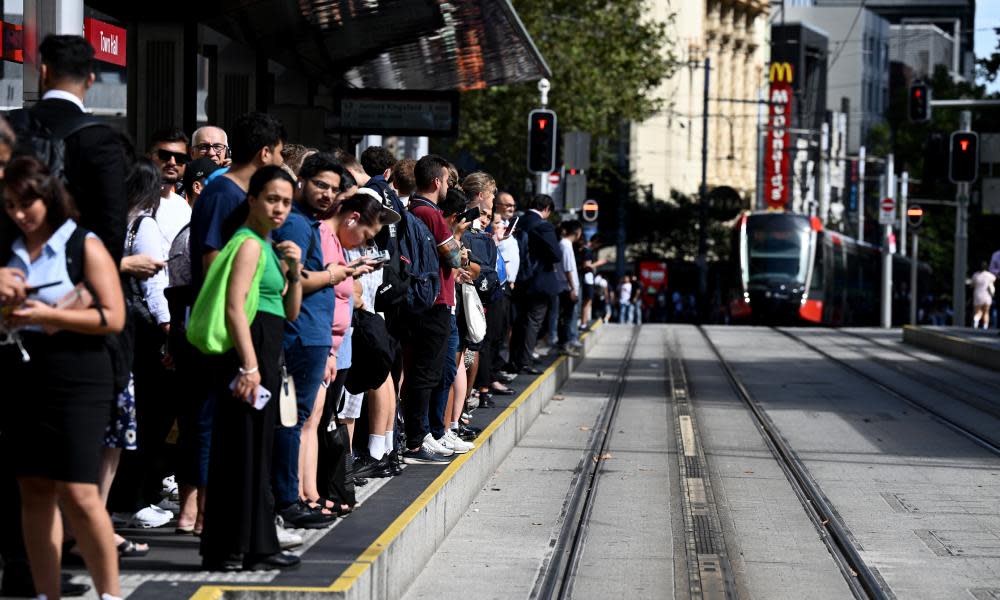Timid NSW transport policies show Labor and Coalition have taken their feet off the accelerator

Sydney has been treated to a boom in public transport and road construction over the past decade but the so-far timid transport policies of the New South Wales election raise concerns the foot is coming off the accelerator.
The main policy differences to emerge between the Coalition and Labor surround how each side plans to expand the metro network westwards, Band-Aid solutions to address the cost of commuting through Sydney’s tolling mess and support for a contentious tunnel.
Sydney’s public transport and road network today looks vastly different to when the NSW Coalition came to power in 2011 but the government’s legacy to date has been mixed. One success it can point to is light rail: trams are running through the city again, in part down pedestrianised stretches of the city centre which are now revitalised.
Related: NSW Greens propose to make public transport free – and pet-friendly
Commuters have also had a taste of 21st-century rail technology with the first section of the Sydney Metro. While the wait was long, the very visible years of construction allowed residents to plan where to work and live. When the extended line opens in coming years, it will be transformational in moving people through the city faster. Those living near stations may think twice about relying on a car.
Then there have been more controversial projects, such as WestConnex and the vast network of privatised roads charging hefty tolls that Sydneysiders will have to navigate for decades to come, with those in the west feeling the greatest pinch.
While travel times have improved, driving from Bankstown to Barangaroo sets you back more than $56. Fees will increase progressively and time savings from the roads are likely to diminish as the direct route incentivises further car uptake in Sydney’s west.
Labor is banking on the frustration of what it has dubbed Sydney’s “tollmania” amid the cost-of-living crisis. The opposition leader, Chris Minns, has proposed capping an individual’s weekly toll spend at $60, which is more generous than the Coalition’s existing rebate scheme. But the toll relief policies of both sides will ultimately be borne by the taxpayer, not private operators.
Sign up for Guardian Australia’s free morning and afternoon email newsletters for your daily news roundup
If Minns becomes premier he won’t be able to unscramble the omelette that is Sydney’s mishmash of private tolling agreements but he has vowed to keep the under-construction Western Harbour tunnel crossing in public hands.
One key policy difference is the Beaches Link tunnel. Promised to bust traffic in the car-dependent northern beaches of Sydney, the project has faced years of pushback, including from neighbouring communities with environmental concerns.
Minns has promised to scrap it. The Perrottet government insists it is committed to the tunnel pending planning approvals but it has been curiously silent on the project. The Beaches Link has not been mentioned in any Coalition press release this year and no timeline is set for construction.
Labor has also said it will explore undoing bus contract privatisations, which have been accused of hurting service quality – and prompted frustrated residents to crowdfund their own “pirate” buses.
But there are now fears that deepening state debt will sink the political will to keep the momentum on building big-picture city-shaping projects.
And here lies the clearest policy difference: spending on metro expansion.
The Perrottet government will push ahead with business cases for four lines to link up with the future western Sydney airport. Labor will only proceed with two, with the Coalition accusing it of deserting western Sydney, an area earmarked for extraordinary residential development in coming years.
While Labor’s hesitance stems from the position of financial responsibility it is keen to project, the Coalition has been cornered into pledging against further privatisation to fund infrastructure builds.
After all, these metro commitments are for business cases only, which means they are far from a guarantee, especially under Perrottet.
This month Guardian Australia revealed that the state government quietly killed work on the final business case to build its own dedicated fast rail line between Sydney and Newcastle. That’s despite four years and roughly $100m spent on feasibility studies for the policy, which Gladys Berejiklian took to the 2019 election.
Abandoning the ambition has prompted concern the state’s landmark Six Cities policy to spread population growth outside Sydney is now destined to fail.
Related: UK professor behind NSW fast rail strategy criticises Coalition for dropping plan
But even Labor is not backing dedicated fast rail, something it knows will be seriously costly and won’t deliver visible benefits before the next election.
Both parties’ sheepishness have urban planners worried.
“We are still playing catch-up when it comes to transport infrastructure,” said Eamon Waterford, the new chief executive of the Committee for Sydney, who, until February, was chief strategy officer at the Department of Investment and Trade. “Sydney is growing fast, we might never catch up but we should try our hardest.
“It’s like eating an elephant, you’ve got to do it one bit at a time.”
In its priorities for a future NSW government issued on Friday, the committee urges progress on metro and fast rail projects.
“We’ve got a lot of people in Sydney now who are very good at building things,” Waterford said. “If we take our foot off the accelerator that expertise will go elsewhere.”
Whoever wins the election, the task of tackling clogged roads, falling public transport use post-Covid and easing growing pains as Sydney expands is immense.

 Yahoo News
Yahoo News 
